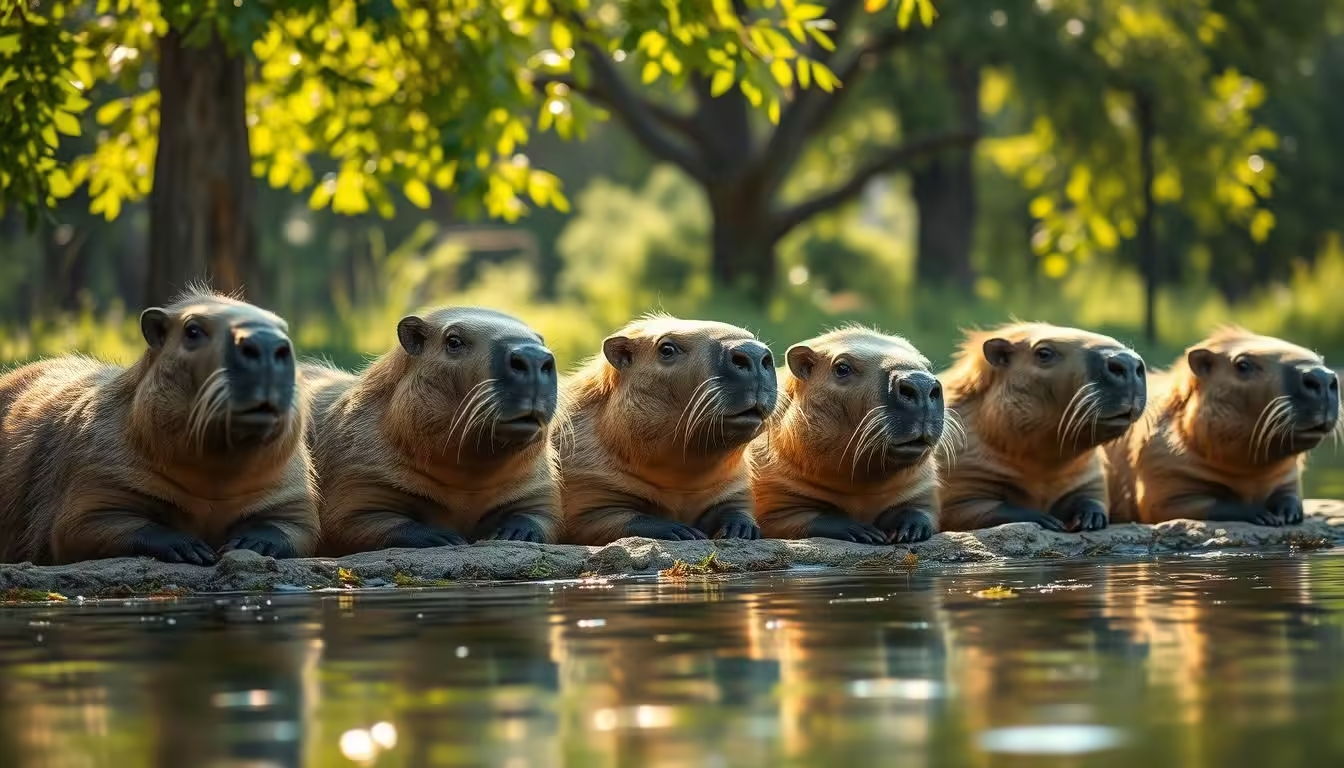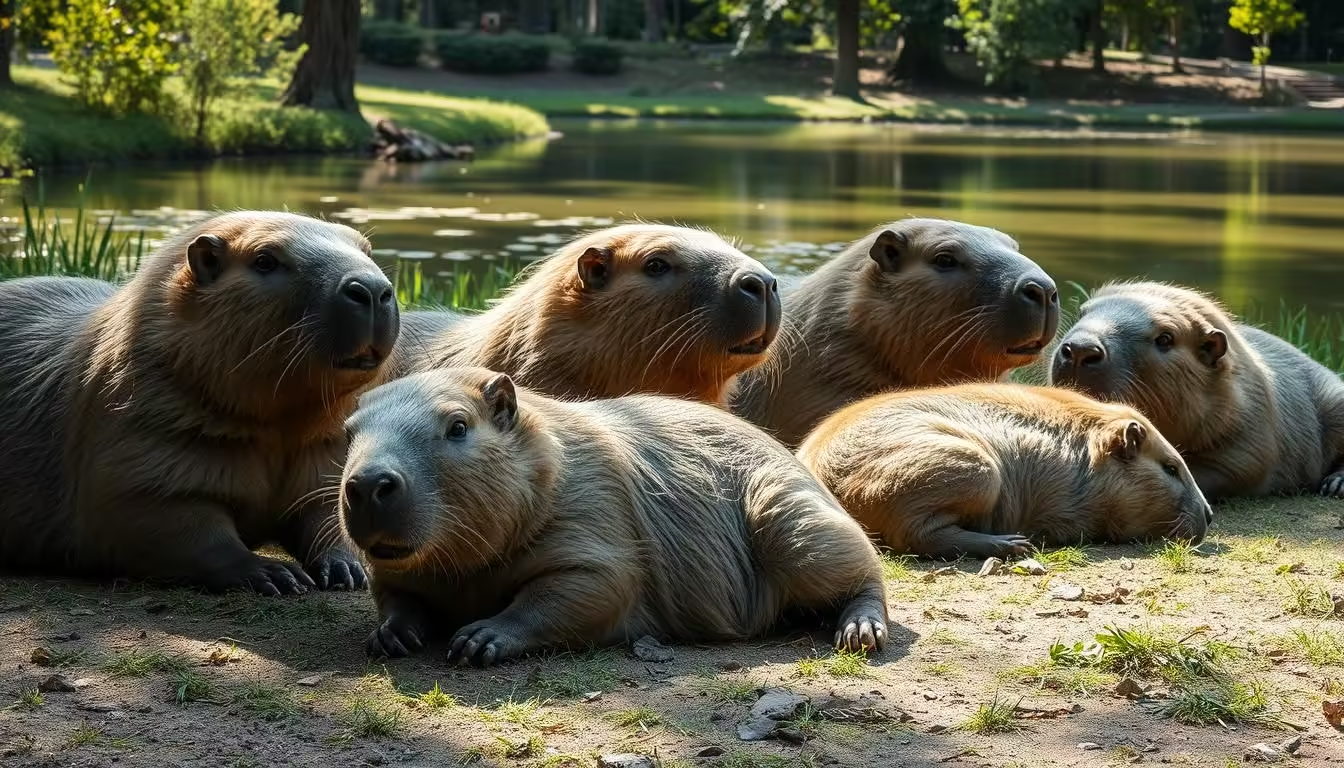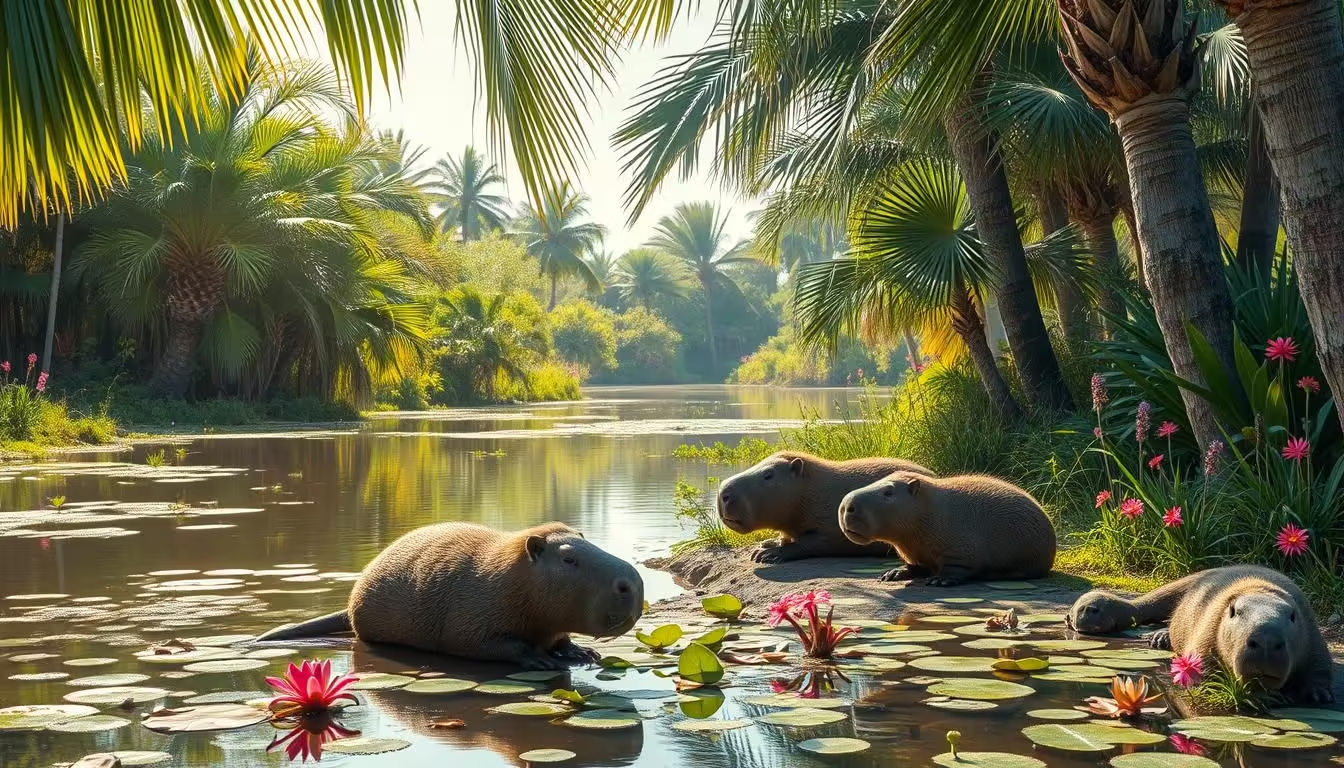Some Capybaras have lived much longer. This article explores the lives of the oldest capybaras, showing their remarkable ability to live long lives.
Key Takeaways
- The oldest recorded capybara in captivity lived to be 15 years old at Adelaide Zoo in Australia.
- Capybaras can reach a top speed of 22 mph, making them as fast as a small horse.
- Capybaras are found in high-density areas of South America, including the Llanos, Pantanal, and Marajo islands.
- Capybaras can tolerate a wide range of temperatures, from 4°C (40°F) to 32–38°C (90–100°F).
- Capybaras typically respond well to a 12-hour light and 12-hour dark cycle in captivity.
Natural Lifespan Factors
In the wild, capybaras face many challenges. As they age, their digestive system changes, making it harder to get nutrients. They also need water, food, and protection from predators to live longer.
Environmental Impact on Age
The size of a capybara’s territory affects their health. In the wild, it ranges from 5 to 16 hectares. But, in captivity, they have a controlled environment, regular care, and food. This helps them live longer.
Health Considerations in Different Settings
In the wild, capybaras face threats like predators. This can shorten their life. But, in captivity, they are safe, have steady food and water, and get vet care. This makes them live longer.
“Protein, vitamins, and omega-3 fatty acids have shown high potential in enhancing the welfare and quality of life for ageing wild animals.”
Understanding capybara longevity helps us see their challenges in the wild and benefits in captivity. This knowledge helps in conservation and caring for these amazing animals.
The Evolution of Capybara Species Through Time
Capybaras have a rich history. Fossil discoveries have revealed their origins and how they spread. A key find is Hydrochoerus hesperotiganites in San Diego County, California.
This species is close to the modern capybara, Hydrochoerus hydrochaeris. It’s the first fossil of the Hydrochoerus genus found in North America. The discovery of H. hesperotiganites gives us insights into capybara history during the Pleistocene era.
The fossil of H. hesperotiganites shows capybaras’ ability to adapt and survive. This ancient species lived with other famous Pleistocene animals. It gives us a peek into capybara evolution.
“The discovery of Hydrochoerus hesperotiganites in North America expands our understanding of the biogeographic range and dispersal patterns of capybaras throughout their evolutionary history.”
More fossil finds will continue to tell the story of capybara evolution. They offer insights into their adaptations and migrations over time.
Top 5 Oldest Capybaras Known in Captivity and the Wild
Capybaras, the world’s largest rodents, live long lives. Some reach ages that amaze us in both zoos and the wild. Let’s look at the top five oldest capybaras ever recorded.
Adelaide Zoo’s Record Holder
The oldest capybara lived 15 years at the Adelaide Zoo in Australia. This shows the great care the zoo staff gave. It helped this capybara live longer than most in captivity.
Notable Mentions from South America
In South America, capybaras can live up to 12 years in zoos. But, in the wild, they face more challenges. This leads to shorter lives for wild capybaras.
Remarkable Cases in North American Facilities
In North America, some capybaras have lived long lives. Though their ages are not always recorded, they have won the hearts of many. They show how well capybaras can adapt with the right care.
“Capybaras are known for their calm demeanor, slow and methodical movements, and friendly interactions with both humans and other species. Their impressive longevity is a testament to the species’ robustness and adaptability.”
Factors Affecting Capybara Life Expectancy
The lifespan of a capybara is influenced by many factors. These include their access to essential resources and the environmental pressures they face. Understanding these capybara lifespan factors is key to appreciating their survival and longevity.
One major factor is their access to water. As semi-aquatic creatures, capybaras need water for thermoregulation, predator avoidance, and food. The quality of their capybara habitat affects their ability to thrive and live a long life.
Environmental impact also plays a big role. Factors like food availability, predation, and disease can affect a capybara’s survival and longevity. They need a balance of grazing areas, protective vegetation, and secure water access to live up to 8-10 years on average.
- Capybaras live longer in captivity, where they are safe from predators and have steady food and water.
- In the wild, capybaras usually live less than four years due to predators like large cats, eagles, and caimans.
- The size and quality of their habitat are crucial for their lifespan. Larger, well-protected territories offer better survival chances.
“Capybaras are remarkably resilient creatures, but their longevity is ultimately tied to the health and stability of their natural environment.”
By understanding the various capybara lifespan factors, we can better appreciate the delicate balance these fascinating rodents must maintain to thrive and reach their full potential lifespan.
Scientific Research on Capybara Aging Patterns
Scientists are studying capybaras to learn about their long lives. They look at biological signs and genetic factors. This helps us understand why capybaras live so long.
Biological Age Indicators
Researchers focus on finding reliable age markers for capybaras. They study how the body changes with age. This helps in caring for older capybaras in zoos and the wild.
Genetic Factors in Longevity
Genetics play a big role in capybara longevity. Scientists study their genes to find out why they live up to 10 years. This research could help us learn more about aging and longevity.
Research Methodology
To study capybara aging, researchers use field studies and lab work. They watch capybaras in their natural habitat and in controlled settings. This method gives a full picture of their aging process.
“The study of capybara longevity holds the potential to unlock valuable insights into the aging process, with broader implications for understanding and improving the well-being of other species.”
Habitat’s Role in Capybara Longevity
Capybaras, the world’s largest living rodents, live in diverse wetland ecosystems in South America. Their habitat, from flooded grasslands to lowland forests, is key to their lifespan and health.
They need a territory of 5 to 16 hectares with easy water access. These semi-aquatic creatures spend a lot of time in water. They also need grazing areas and dense scrub for shelter and protection.
- Capybaras in well-preserved wetland ecosystems live about 4 years in the wild.
- Those in human care can live up to 10 years, thanks to better care and resources.
The quality and size of a capybara’s habitat greatly affect their longevity. Larger, healthier wetlands with reliable water and plenty of vegetation help them live longer. This is especially true when there’s less human impact.
“Capybaras are highly adaptable and can survive in a variety of wetland environments, but their natural habitat is truly the key to their longevity and overall well-being.”
Conservation efforts to protect wetlands are crucial for capybara populations. By preserving these ecosystems, we can help these remarkable rodents thrive for many generations.
Healthcare and Management of Senior Capybaras
As our beloved geriatric capybaras age, we must focus on their healthcare and management. These semi-aquatic rodents need special care for their diet and health. This ensures they live long, happy lives in their senior years.
Dietary Requirements
Capybaras love to eat grasses and aquatic plants. They also eat their own poop to get more nutrients. In captivity, it’s important to manage their diet well as they get older.
Their diet needs change with age. They need a special diet that meets their nutritional needs.
- Emphasis on high-fiber, nutrient-dense grasses and hay
- Incorporation of leafy greens and aquatic plants to mimic their natural foraging habits
- Supplementation with essential vitamins and minerals to support overall health
- Monitoring and adjusting portion sizes to maintain a healthy weight
Medical Care Considerations
There’s not much info on senior capybara healthcare. But keeping them active and well-fed is important. It’s best to get advice from a vet to create a care plan for them.
- Regular wellness checks and preventive screenings to identify any age-related issues
- Specialized treatments and medications to manage chronic conditions or age-related diseases
- Adaptations to the captive environment to accommodate mobility or sensory changes
- Behavioral enrichment and mental stimulation to promote overall well-being
By focusing on the healthcare and management of senior capybaras, we can help them live long, happy lives. They will continue to amaze us with their charm and personality.
Comparing Capybara Lifespan to Other Rodents
Capybaras, the largest living rodents, live quite long. In the wild, they can live 6 to 10 years. Some even reach up to 12 years in captivity. This is longer than many smaller rodents.
Let’s look at how other rodents compare:
- Mice and rats usually live up to 4 and 5 years, respectively.
- Some rodents, like naked mole-rats, beavers, porcupines, and certain squirrels, can live over 20 years.
- The eastern grey squirrel, Prevost’s squirrel, Indian giant squirrel, and red and white flying squirrel can live up to 24 years.
- Ground-dwelling chipmunks, like the Eastern American chipmunk, can live up to 9.5 years.
- The black-tailed prairie dog can live up to 11 years. The yellow-bellied marmot can reach 21 years, and the common woodchuck lives for 14 years.
- Old World mice, rats, and hamsters usually live less than 5 years. New World species like the deer mouse and white-footed mouse can live up to 8 years.
- Canadian beavers have the longest lifespan among rodents, living up to 23 years.
Compared to these rodents, capybaras’ 6 to 12-year lifespan is impressive. It shows their unique traits and adaptations that help them live longer than others in the rodent order.
| Rodent Species | Maximum Lifespan |
|---|---|
| Capybara | 12 years |
| Mice | 4 years |
| Rats | 5 years |
| Naked Mole-Rats | Over 20 years |
| Beavers | 23 years |
| Porcupines | Over 20 years |
| Eastern Grey Squirrel | 24 years |
| Eastern American Chipmunk | 9.5 years |
| Black-tailed Prairie Dog | 11 years |
| Yellow-bellied Marmot | 21 years |
| Common Woodchuck | 14 years |
| Deer Mouse | 8 years |
| White-footed Mouse | 8 years |
| Canadian Beaver | 23 years |
This comparison shows how remarkable capybaras are among rodents. It highlights their evolutionary traits and what helps them live so long.
Modern Conservation Efforts and Impact on Longevity
Capybara conservation focuses on saving their wetland homes and balancing human and wildlife needs. While we don’t have details on specific programs, it’s clear they’re key to capybaras’ long lives. By protecting their habitats and reducing human-wildlife conflicts, these efforts help capybaras thrive and live longer.
Keeping capybara habitats safe is crucial. These big rodents need wetlands, riverbanks, and marshes to survive. Conservation works to protect these areas through land and water management and limiting human impact. This ensures capybaras can live their full lives in their natural habitats.
Wildlife management also plays a big role in capybaras’ longevity. This includes tracking populations, controlling diseases, and harvesting sustainably. These practices help keep capybara communities healthy and strong. By supporting these efforts, we help capybaras live well in their natural homes.



